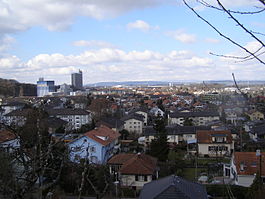Ostermundigen
| Ostermundigen | ||
|---|---|---|
 |
||
|
||
| Coordinates: 46°57′N 7°29′E / 46.950°N 7.483°ECoordinates: 46°57′N 7°29′E / 46.950°N 7.483°E | ||
| Country | Switzerland | |
| Canton | Bern | |
| District | Bern-Mittelland | |
| Government | ||
| • Executive |
Gemeinderat with 7 members |
|
| • Mayor |
Gemeindepräsident Thomas Iten Ind. (as of March 2014) |
|
| • Parliament |
Grosser Gemeinderat with 40 members |
|
| Area | ||
| • Total | 5.94 km2 (2.29 sq mi) | |
| Elevation | 585 m (1,919 ft) | |
| Population (Dec 2015) | ||
| • Total | 16,788 | |
| • Density | 2,800/km2 (7,300/sq mi) | |
| Demonym(s) | Mundige | |
| Postal code | 3072 | |
| SFOS number | 0363 | |
| Surrounded by | Bern, Bolligen, Ittigen, Muri bei Bern, Stettlen | |
| Website |
www SFSO statistics |
|
Ostermundigen is a municipality in the Bern-Mittelland administrative district in the canton of Bern in Switzerland.
The city is the birthplace of screen legend, Ursula Andress.
Most of the buildings in the UNESCO World Heritage Site of the Old City of Bern were built from sandstone quarried in Ostermundigen.
Ostermundigen is first mentioned in 1239 as Osturmundingun. In 1279 it was mentioned as Ostermundigen.
Ostermundigen developed from three medieval villages (the upper, middle and lower villages) which formed a single community. The three villages were surrounded by fourteen fields that were held as fiefs by various nobles. In between the fields, a number of small hamlets developed including; Deisswil, Dennigkofen, Rörswil, Rothus and Wegmühle. Politically and religiously it was part of the municipality of Bolligen, however, the Holzgemeinde (forest cooperative) administered the limited common forest land.
The villages of Ostermundigen formed a quarter of the parish of Bolligen, along with the quarters of Ittigen, Ferenberg and Bolligen. After the Protestant Reformation in 1528 entered the parish, the quarters became partially autonomous. Each quarter was now responsible to care for the poor and orphans and to provide education for the residents of that quarter. Eventually the Holzgemeinde became responsible for providing an education and caring for the poor. They built the first school house in 1746. By the early 19th century, this arraignment had created a complex and unwieldy municipal power structure with five different councils (Holzgemeinde, village, school, quarter and road repair and maintenance) all holding overlapping powers. This was in addition to the municipal and parish councils in Bolligen. In 1856, the citizens of Ostermundigen combined the Holzgemeinde, village council and quarter council into one. The road repair council and the quarter council merged in 1872. In 1945, the school district and the quarter finally merged which finally gave the Ostermundigen quarter a unified administrative structure. However, the municipal organization was still divided, with a complex division of powers between the municipality and the quarters. Following a long running debate on whether to centralize (1930, 1945, 1963), incorporate in Bern (1913, 1919) or decentralize (1956, 1962, 1972), in 1978 the residents decided to divide the municipality into three independent municipalities; Bolligen, Ittigen and Ostermundigen. From 1980 until 1983, the community completed the process of becoming an independent municipality.
...
Wikipedia



